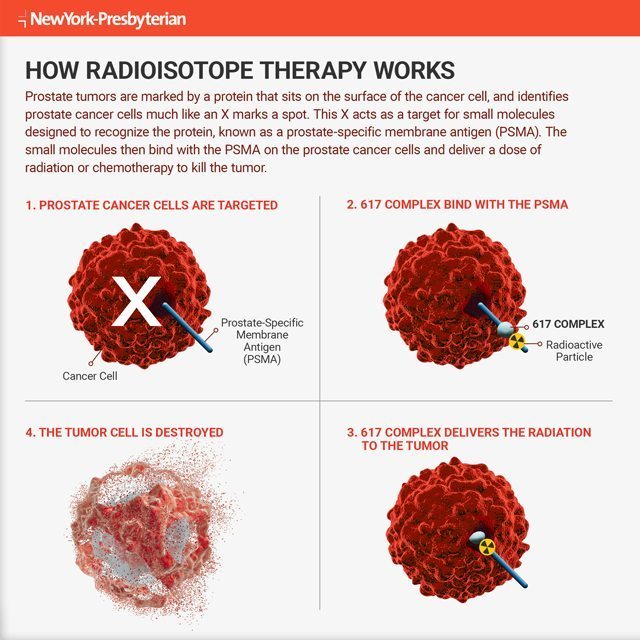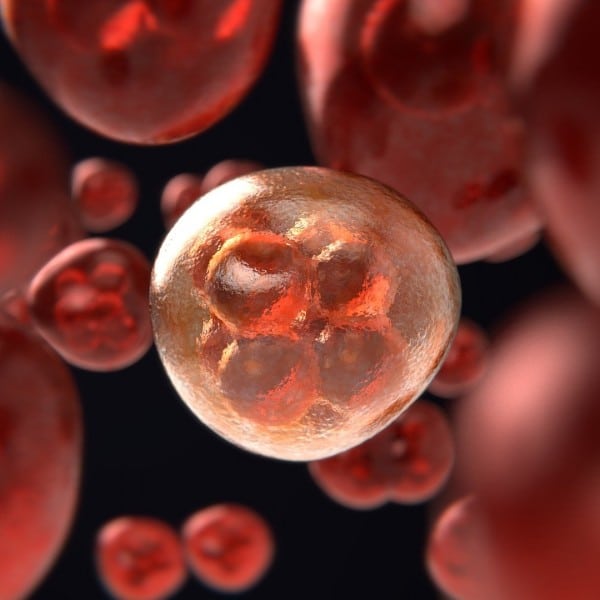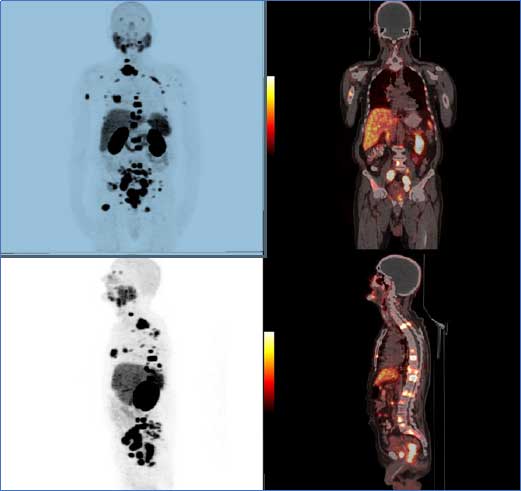Some Side Effects Could Be Serious
If you experience any of the following serious side effects, tell your nuclear medicine doctor or oncologist right away.
Very common: may affect more than 1 in 10 people
- tiredness, weakness, pale skin or shortness of breath
- bleeding or bruising more easily than normal or difficulty to stop bleeding and frequent infections with signs such as fever, sore throat or mouth ulcers
Common: may affect up to 1 in every 10 people
- passing urine less often than usual or passing much smaller amounts of urine than usual
- tiredness, weakness, pale skin, shortness of breath, bleeding or bruising more easily than normal or difficulty to stop bleeding and frequent infections with signs such as fever, chills, sore throat or mouth ulcers
What Is The Effectiveness Of The Drugs
The effectiveness of treatment with radiopharmaceuticals is most objectively reflected in the results of clinical trials. Unlike the practice of individual doctors, even in the largest medical centers with nuclear medicine, clinical trials include hundreds and thousands of patients with the same diagnoses. They help to collect large amounts of reliable information about the effectiveness of individual drugs, the incidence of side effects, and the possibility of combining different treatments:
The Role Of Nuclear Medicine In Prostate Cancer Treatment
The destruction of cancer cells using ionizing radiation has long been a standard treatment protocol for many cancers. However, radiation therapy often affects not only the tumor, but also the surrounding healthy tissue. In prostate cancer, this leads to unwanted damage to the bladder, intestines, liver, and other important organs. The narrowing of the irradiation zone and targeted irradiation of malignant foci are the principles that formed the basis for the development of radionuclide therapy.
Nuclear medicine offers a safer and more effective treatment for prostate cancer, with radioactive nuclides radioactive isotopes of stable elements that recognize tumor cells and metastases and irradiate them with high precision. Individual radioisotopes can be incorporated into bone tissue, mimicking its normal elements this property is used in the treatment of bone cancer metastases.
Isotope therapy is used in the advanced, metastatic stages of cancer, when other treatments have not led to an improvement in the patient’s condition and did not slow down the further progression of the oncological disease. In particular, in cases of prostate cancer, treatment with drugs such as Actinium-225 and Lutetium-177 is carried out on men who have already undergone the following treatment methods without gaining any results:
We will consider the features of the actions of various therapeutic radionuclides below.
You May Like: Best Prostate Supplements Consumers Report
Who Are Good Candidates For Lutetium Psma
Lutetium-177 PSMA is employed for metastatic prostate cancer patients, for whom other treatment modalities, such as hormone therapy or chemotherapy, have failed.
The patients should have a PSMA PET-CT scan before the treatment and PSMA receptors to be targeted in Lutetium-177 PSMA and their presence on cancer cells should be verified.
How You Get It

PSMA therapy usually takes place in a hospitalâs nuclear medicine department. A health care professional injects the medicine into a vein in your arm.
It takes about 30 minutes for the drug to infuse into your bloodstream.
You get anti-nausea meds and a diuretic to help flush the Lu 177 from your system. After that, you may need to wait in the hospital for a few hours or longer to make sure your radiation levels start to come down.
A day or two after your treatment, you’ll have an imaging test called a single-photon emission computerized tomography scan. This checks to make sure your therapy hit the right targets.
Recommended Reading: What Does Prostate Cancer Feel Like
How Lutetium Vipivotide Tetraxetan Is Stored
You will not have to store this medicine as you will receive this medicine in hospital. This medicine is stored under the responsibility of the specialist in appropriate premises. Storage of radiopharmaceuticals will be in accordance with national regulations on radioactive materials.
The following information is intended for the specialist only.
- Keep this medicine out of the sight and reach of children
- Store below 30°C. Do not freeze
- Store in the original package to protect from ionising radiation
- Do not use lutetium vipivotide tetraxetan after the expiry date and time which are stated on the label after EXP
In What Cases Are Specific Drugs Used
In the summer of 2021, the FDA approved Lutetium-177-PSMA-617 for the treatment of castration-resistant metastatic prostate cancer. Clinical trials are also being conducted on the use of this drug in the earlier stages of prostate cancer. To date, indications for the use of Lutetium-177-PSMA-617 are as follows:
What are the pros and cons of treatment with Lutetium-177-PSMA? Lutetium-177-PSMA therapy is the treatment of choice for men with metastatic prostate cancer who have not been successfully treated with hormone therapy and chemotherapy. Your doctor may recommend this treatment after prostate resection, antiandrogen drugs, and chemotherapy. When replacing these types of treatment with Lutetium-177-PSMA therapy, you will no longer need to constantly take pills.
The alternative treatment with Actinium-225-PSMA is carried out under similar conditions and after the ineffectiveness of 1-2 courses of treatment with Lutetium-177-PSMA. Actinium-225-PSMA binds more strongly to tumor receptors, its half-life is 60% longer than the half-life of Lutetium-177, and the radius of action is only 1-2 cells .
Read Also: What To Expect After Prostate Is Removed
Two Agents Approved For Psma
On May 26, FDA approved piflufolastat F 18 for use in a type of imaging procedure called PSMA PET in people with prostate cancer. The approval covers the use of piflufolastat F 18 in patients suspected of having metastatic prostate cancer or recurrent prostate cancer . Last year, the agency approved another imaging agent for PSMA PET, Ga 68 PSMA-11, for the same uses, but its use is largely limited to the two institutions where it is made.
In a statement, Lantheus, which manufactures piflufolastat F 18, said the imaging agent will be immediately available in parts of the mid-Atlantic and southern regions with broad availability across the U.S. anticipated by year end.
PSMA is often overproduced by prostate cancer cells but is generally not produced by most normal cells, making it an excellent target for both PET imaging and targeted systemic radiation therapy like 177Lu-PSMA-617, Dr. Morris said.
How Safe Is Lutetium
Lutetium-177 is capable of damaging and destroying cancer cells. Moving towards the tumor sites, it targets malignant cells. However, on its way, it enters salivary and tears glands, as well as kidneys and small intestine. Those organs may suffer from minimal side-effects.
Among such side effects are abdominal pain, nausea, vomiting, and rarely hair loss. Lutetium-177 is toxic to kidneys and bone marrow.
Despite that, the patients life quality noticeably improves. Their pain is relieved, the size of the lesion is reduced and they can partially return to their daily activities.
Don’t Miss: Can Prostate Problems Cause Burning Urination
What Causes Prostate Cancer
Prostate cancer is the most common form of cancer in men over the age of 50. Currently, researchers are unable to determine exactly what causes prostate cancer. DNA changes that are inherited or caused by certain lifestyle choices are believed to play a role in why some individuals develop cancer and others do not. It is believed that inherited genes account for about 5 to 10 percent of prostate cancers. Exposure to radiation, chronic inflammation, exposure to cancer-causing chemicals, high levels of androgens, or insulin-like growth factor-1 are also all believed to cause gene changes which lead to cancer.
Targeting Psma: Not Just For Imaging
Like a number of other radiopharmaceuticals, 177Lu-PSMA-617 has two components: a drug that delivers the therapy to cancer cells and a radioactive particle. In the case of 177Lu-PSMA-617, the delivery vehicle is PSMA-617, a drug that latches onto a protein called PSMA that is often found at high levels on the surface of prostate cancer cells. The radioactive component is lutetium-177, which is being tested as a part of multiple radiopharmaceutical drugs.
As Dr. Morris explained, PSMA-617 is extremely adept at finding and locking on to the PSMA protein on cells. Once it binds to PSMA on a cancer cell, the whole molecule is internalized by the cell and the cell is exposed to a lethal dose of radiation from lutetium-177, he said.
The PSMA protein is also at the heart of a new type of imaging procedure called PSMA PET. This form of PET imaging is just starting to be used in men with prostate cancer to determine whether their cancer has spread, or metastasized, beyond the prostate. In the last several months, FDA has approved two such drugs, known as radiotracers, for PSMA PET imaging.
Don’t Miss: What Is The Latest Treatment For Enlarged Prostate
How Lutetium Vipivotide Tetraxetan Works
Lutetium vipivotide tetraxetan binds to a protein called PSMA that is found on the surface of prostate cancer cells. Once bound, radiation is emitted from the 177Lu causing prostate cancer cells to die.
Tests will be performed to see if PSMA is present on the surface of the cancer cells. Your cancer is likely to respond to treatment with lutetium vipivotide tetraxetan if the test result is positive.
The use of lutetium vipivotide tetraxetan involves exposure to radioactivity. Your doctors have considered that the clinical benefit that you will obtain from the procedure with the radiopharmaceutical outweighs the risk due to radiation.
If you have any questions about how lutetium vipivotide tetraxetan works or why this medicine has been prescribed for you, ask your doctor.
Why Should Someone Come To Uchicago Medicine For Lutetium

At UChicago Medicine, we’ve treated more patients with this combination than anyone in the area because we were the only hospital in the region to be involved in lutetium-177 PSMA and gallium-68 PSMAs expanded access program prior to their approval. We have expertise across modalities from the imaging and radioactive material handling to our healthcare providers who help patients navigate the process safely and efficiently. As theranostics is a new type of therapy, having the most experience in the region is critical to helping patients navigate the process. We are leaders in nuclear medicine and have participated in numerous clinical trials for theranostics. And with the only medical cyclotron in the state of Illinois and our partnership with Argonne National Laboratory, we continue to be at the forefront in theranostics research.
Don’t Miss: Prostate Cancer Metastasis To Bone
What Are The Benefits
Positive outcomes will be obtained in approximately 60 to 70% of the patients and long-term regression of the disease can be achieved in certain cases. Moreover, expected survival time can also be prolonged.
Large-scale trials are maintained in Australia and the U.S. to determine the full range of benefits.
Lutetium Vipivotide Tetraxetan: Treatment Protocol: Information For Patients
This publication is licensed under the terms of the Open Government Licence v3.0 except where otherwise stated. To view this licence, visit nationalarchives.gov.uk/doc/open-government-licence/version/3 or write to the Information Policy Team, The National Archives, Kew, London TW9 4DU, or email: .
Where we have identified any third party copyright information you will need to obtain permission from the copyright holders concerned.
This publication is available at https://www.gov.uk/government/publications/lutetium-177lu-vipivotide-tetraxetan-in-the-treatment-of-prostate-specific-membrane-antigen-psma-positive-metastatic-castration-resistant-prostate/lutetium-177lu-vipivotide-tetraxetanin-treatment-protocol-information-for-patients
Also Check: What Does Grade 4 Prostate Cancer Mean
The Royal Marsden To Start Offering Lutetium Psma Therapy To Treat Advanced Prostate Cancer
Patients with advanced metastatic castration resistant prostate cancer to be offered an innovative molecular therapy which precisely targets cancerous cells reducing the exposure to the rest of the body.
Lutetium-177 PSMA is an innovative therapy used to treat metastatic castration resistant prostate cancer. The therapy works to reduce the tumour size and prevents the tumour from increasing, whilst also helping to improve the symptoms that these tumours might cause.
PSMA is naturally found on the surface of prostate cells in someone with prostate cancer there is an increase of PSMA expression. If the prostate cancer has spread to other parts of the body the PSMA will also be present in those areas. When administered intravenously the Lutetium-177 PSMA ligand will travel to those areas where the PSMA is present and emits radiation that will destroy the cancer cells the treatment is targeted to the cancer with very little radiation exposure to other parts of the body.
The Royal Marsden will offer PSMA therapy, which will be administered by an expert multi-disciplinary team. Nuclear Medicine consultants, Urologist consultants, specialised Nuclear Medicine nurses, Ward nurses, Nuclear Medicine Technologists, and Nuclear Medicine Physics team will work together to ensure the best treatment and care.
All the potential side effects and the necessary precautions will be carefully explained to patients during the clinic appointment with the Nuclear Medicine consultant.
When Would I Consider Using This Treatment
Lutetium-177 therapy is only used on men who suffer from cancer that has originated in the prostate and who have exhausted other previous lines of treatment. It has proven itself to be an effective therapy for managing metastatic prostate cancer or cancer of the prostate after other types of treatment have failed.
Nearly all types of prostate cancer will produce excessive PSMA, however, prior to starting the therapy, a diagnostic scan is performed to ensure the Lutetium-177 radiation will target the right areas during treatment.
You May Like: Herbal Treatment For Enlarged Prostate
What You Need To Know Before Lutetium Vipivotide Tetraxetan Is Used
Follow all instructions given by your nuclear medicine doctor or oncologist carefully. They may differ from the general information contained in this leaflet.
Your doctor must not give you lutetium vipivotide tetraxetan if you are allergic to lutetium vipivotide tetraxetan or any of the other ingredients of this medicine .
If You Forget To Receive Lutetium Vipivotide Tetraxetan
If you miss an appointment for an administration, contact your nuclear medicine doctor or oncologist as soon as possible to reschedule.
Should you have any further questions on the use of lutetium vipivotide tetraxetan, please ask the nuclear medicine doctor or oncologist who supervises the procedure.
Don’t Miss: Late Stage Prostate Cancer Treatment
Advantages Over Standard Treatment
Lutecium-177 prostate cancer therapy is the type of treatment when radiation is delivered directly to the focus of the disease – cancer cells. PSMA therapy is recommended for patients with a resistant and widespread form of cancer, metastatic castration-resistant prostate cancer, whose condition has deteriorated despite traditional treatment.
PSMA therapy has many advantages over conventional methods of malignant prostate formation:
- Only cancer cells are exposed to radiation drugs without disturbing the healthy cells
- The components of the drug affect cancer cells regardless of their location, which allows you to fight not only the primary tumour but also metastases
- The possibility of using the drug at any complexity of the disease, regardless of the stage
- The method of treatment is characterized by high safety and quite good tolerance, despite the possible general weakness
- Receiving, if necessary, several treatment sessions and the possibility of combining with other treatment methods
When Would I Consider Using This Treatmentkeyboard: Arrow: Down

Lutate therapy is used on people with cancer originating in the prostate. It is very specific and is used for managing metastatic prostate cancer or prostate cancer that is no longer responsive to other lines of treatment therapy. Candidates are identified after a Gallium 68 PSMA PET CT scan has been performed.
Read Also: How Long Can You Live With Stage 4 Prostate Cancer
When Should We Use A Specific Method Of Nuclear Medicine
What are the differences between methods of cancer treatment with nuclear medicine? Differences in the action of radionuclides are caused by two main parameters:
Radionuclide therapy entered the clinical practices of developed countries of the world more than 40 years ago. During this time, scientists have accumulated practical experience in the use of various radioactive isotopes in prostate cancer treatment and have identified the most effective and safe of them. As of today, the updated protocols for the treatment of cancer of various localizations include the use of 4 main medicines. These are as follows:
| Radionuclide |
|---|
How Does Lutetium Psma Therapy Work
PSMA is a type of protein found on the surface of a cell. Its located on the prostate gland, some tumours, and normal tissues.
If you have prostate cancer, youll have more PSMA than normal. If the prostate cancer has spread to other parts of the body , the PSMA will also be there.
Lutetium-177 PSMA therapy uses a molecule which attaches itself to the PSMA receptors on the cancer cells.
Before its given to you, the PSMA molecule is bound with lutetium-177. This is a radioactive substance that damages and destroys the prostate cancer cells in a targeted way.
The PSMA molecule transports the lutetium-177 direct to the tumour site. That means the rest of your body isnt exposed to radiation.
Recommended Reading: Prostate Cancer Gleason Score 9 Life Expectancy